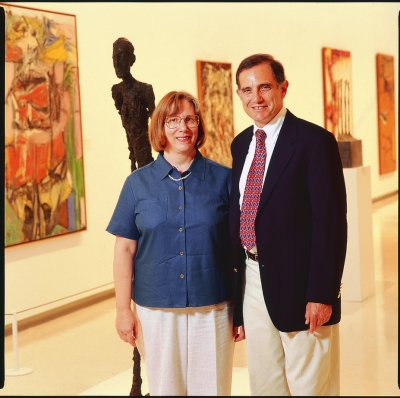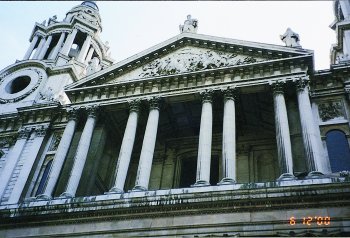For and about Members & Donors

The Baums Capture the Essence of Unrestricted
Annual Giving
Allen and Liz Baum have been members
of Carnegie Patrons Circle for three years. Carnegie Patrons Circle members
provide leadership gifts to support the annual unrestricted operations
of the four museums. This year the Baums’ exemplary giving reached the
President’s Society level.
The Baums capture the essence of unrestricted
annual giving. They have involved with Carnegie Museums of Pittsburgh
for a long time. They live in the East End and raised their two children,
now ages 23 and 19, with frequent visits to the museums. Their daughter
Mara, now an architect intern, went to art classes at the art museum all
through school. Allen has relatives in France whose children frequently
visited them in Pittsburgh. Trips to the Carnegie Museums were frequently
a high point of the their visits.
"We're museum people," says Liz.
Allen notes that they were in France recently for about two weeks and visited
what seemed like 40 museums. "Many other cities have more glamorous
art collections, but Carnegie Museums in Oakland is just a fabulous building,
a wonderful resource for the city. We've seen many prestigious collections--but
they are often housed in more plebian buildings." Liz says, "I always get
a thrill when I come to Oakland and see the school buses lined up in front
of the museum."
The Baums enjoy the exhibition openings,
the museum lectures, and Carnegie Museum of Art film series on Fridays
and Saturdays. They buy gifts at the museum stores. Modern
and contemporary art appeal to them. "The International this year
was great," says Liz. “When our kids were growing up we spent a lot
of time in the Natural History Museum, and we really like the changes that
have been taking place there. It's even more exciting now for young
people."
"As you get older your discretionary income
tends to increase, and it's time to give back," says Allen. "If all the
art collections developed with money made in Pittsburgh had stayed here,
this city would be the top art destination in the country. We can't
change the past, but by supporting Carnegie Museums of Pittsburgh today
we help assure good art for the next generation here. We also want
to help preserve this fabulous building as a Pittsburgh resource.
Personally, we just enjoy coming here." Liz adds, "It is like a second
home to us."

London at Two Millennia
Glimpses of London’s past and present, as
well as a side-trip to signature sites in Spain, were part of the busy
itinerary for members who traveled in June with Carnegie Museums’ Richard
Armstrong and Tom Sokolowski.
“It was fun, and it was somewhat grueling,”
says Richard Armstrong of a recent trip to London with Carnegie Museums
of Pittsburgh members.
“We chose to look at London at the
end of two centuries in which it was a dominant world force, still full
of the buildings, bridges, and railroad stations of the Victorian empire,”
explains Tom Sokolowski. “Post-colonial Britain is a diverse society
today, with new museums, new apartment and office towers.”
“There was a princely leitmotif to
the trip,” Armstrong says, “Beginning with Prince Albert at his memorial
and then, for the rest of the nine days, hearing about what Prince Charles
doesn’t like. It all culminated in a visit to the trooping of the colors.
We had,” he adds wryly, “a royal good time.”
Armstrong, Henry J. Heinz II Director of
Carnegie Museum of Art, and Sokolowski, director of the Warhol Museum,
escorted members to London June 8 through June 18. The tour was epicurean
as well as cultural, hitting as many of London’s top restaurants as time
would permit. “We went to two restaurants designed by Terence Conran,
and one by artist Damien Hirst,” says Sokolowski. “Good design, whether
it is a subway, an office building, or a restaurant, contributes to the
experience. It changes the topography of where you live.” “And
the psychology,” adds Armstrong.
After London, most of the group went on
to Bilbao, Spain, “a steel city in the midst of a resurgence, just like
Pittsburgh,” says Sokolowski, “And the center of the resurgence is the
Guggenheim museum there. The Carnegie Museums could play a similar
role in Pittsburgh.”
The group also took a look at Bilbao’s
new pedestrian bridge and visited a “Fosterino,” the new subway system
designed by architect Sir Norman Foster. “It was 106 degrees,” says
Armstrong. “And we went all the way down into the system; it was
a really good-hearted group.”
Both directors were pleased to see how
many of the artists represented at the Tate Modern or at contemporary exhibitions
have been shown in Pittsburgh, whether in the permanent collections or
previous exhibitions. After the trip, Armstrong continued on
to Basel to its acclaimed contemporary art fair, and Sokolowski went to
Budapest to discuss a Warhol exhibition. In its consideration of
Victorian and new London, and in its whirlwind tour of Bilbao, the group
sought analogues to the changes and aspirations of Pittsburgh.
See New Zealand with Seddon Bennington
February 5-21, 2001
A person could drive from the smoking
volcanoes in the north of New Zealand to the glaciers of the south in one
day. On this 15-day trip led by Seddon Bennington, director of Carnegie
Science Center and a native New Zealander, you will stay in some of New
Zealand's finest hotels and see the best and some of the less trodden paths
of this compact, stunning country.
Highlights in the Auckland area include
the Bay of Islands, the stately Kauri forests, and the Auckland Museum,
with its extensive collection of Maori artifacts. To the south are
the Waitomo caves. “We’ll travel by boat through this limestone network
lit by glowworms,” says Bennington, “It’s quite magical. Then on
to Rotorua, where Maoris still cook their food in the steam vents and boiling
mud.”
A drive through rolling hills and sheep
farms ends in Wellington, the political capital of the country. “Wellington
is built on a fault line so, like San Francisco, it developed a distinctive
wooden colonial architecture,” says Bennington. “The museum there, Te Papa,
houses the national art, natural history, and Maori collections that have
been woven together to tell a coherent story of the country. The different
cultures have a positive relationship, and the museum is the Maori urban
meeting place.”
The group will cross Cook Strait to Picton
and the winemaking region, then down to Christchurch, the garden city of
New Zealand. After crossing the Southern Alps, the tour will follow
the west coast, where the people are few and the forest runs down to the
sea. After Queenstown, set against the dramatic backdrop of The Remarkables
mountains, the tour ends in Dunedin with a visit to the Royal Albatross
colony at Taiaroa Heads.
|

